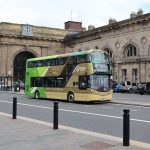Glasgow’s proposed LEZ is set to require Euro 6 compliance across the board for buses in the future. Operator First Bus is already making plans to accommodate that, but a big fleet spend is now needed
.jpg)
The challenged of complying with a proposed Low Emission Zone (LEZ) have been revealed by First Glasgow. It plans to replace 430 buses and retrofit over 300 others to meet Euro 6 standards by the end of 2022.
Exactly how Glasgow’s LEZ will be implemented is still not absolutely clear. Glasgow City Council (GCC) wants yearly increases in a mandatory minimum percentage of buses entering that are Euro 6 compliant, reaching 100% at the end of 2022.
“Operators collectively objected to that because of no effective clarity on retrofit funding,” says First Glasgow MD Andrew Jarvis.
Round one of the Scottish Bus Emissions Abatement Retrofit (BEAR) fund awarded money to pay for the treatment of 47 buses. The maximum amount that each operator could bid for was limited to €200,000. For First Glasgow, that will allow nine vehicles to be dealt with.
Owing to state aid concerns, BEAR round two is limited to 40% of retrofit costs. The remainder is up to the operator. “We argue that the funding still isn’t finalised because we disagree with Transport Scotland’s suggestion that BEAR2 constitutes state aid,” he continues.
First stage soon
Because of that objection, the Traffic Commissioner granted a Traffic Regulation Order introducing the Glasgow LEZ in its first step only. That requires 20% of buses entering the LEZ to be Euro 6 compliant by 31 December, although there is a derogation for services that enter Buchanan bus station via a specified route.
Measuring that accurately will be tricky, but First does not plan to shuffle vehicles and cause ‘emissions displacement’ to meet targets as they are formalised. It already has a plan in place to allow it to comply across its greater Glasgow fleet, hence the volumes of new and retrofitted buses.
But with BEAR2 possibly only covering 40% of retrofit costs, the remainder will ultimately be paid by the end user. While new buses benefit passengers, retrofitted older examples do not, other than allowing them to breathe slightly cleaner air.
“Does that increase customers’ propensity to travel? It’s unlikely,” says Andrew. He anticipates that around 100 buses per year will receive exhaust aftertreatment equipment until the programme is complete. Euro 4 and Euro 5 vehicles will be treated; those from before then will be disposed of.
Combined with a massive investment in new buses, that will leave First Glasgow’s fleet entirely compliant. It will make a big difference to air quality in the city, and although nothing is set in stone, it appears likely that similar standards will follow in other Scottish cities.
Past perception problem?
It’s debatable whether targeting buses first is the right move for an LEZ. But First moved substantial numbers of mid-life vehicles into Glasgow in the past. That may have created a perception that its fleet there is old, giving weight to a prioritisation of tackling bus emissions.
Andrew points out that other methods, such as stronger bus lane enforcement and further priority measures, will increase bus speeds and reduce emissions. First Glasgow’s average speed is 9.06mph, but that includes routes that use motorways.
A look must also be taken at on- and off-street parking, he adds; if the former areas become live road space, speeds will rise. Another idea is reducing the multitude of traffic light-controlled junctions within Glasgow’s grid-like streetscape by pedestrianisation.
“If the LEZ delivers what is hoped, traffic levels will be addressed as long as motorists can see viable options. These have to happen at the same time that we take out parking spaces or impose restrictions on car emissions.”
Partnership working
Glasgow has a recently-formed Bus Partnership. Andrew believes that it will deliver improvements in conjunction with GCC and Strathclyde Partnership for Transport if there is certainty for operators after the LEZ’s full introduction.
“We are assured that emissions from buses can be accurately attributed. But one monitoring centre is adjacent to a taxi rank by Central station. We have flagged that. It is the same in Aberdeen; the harbour is in the city centre and ships’ on-board generators run 24/7.”
Will contributions from marine and rail mitigate the effectiveness of an LEZ? Possibly, and thus the bus industry’s message is not to blame it entirely for pollution. “There will be no point coming back in four years’ time and saying that air quality is still a problem,” says Andrew. “Modelling demonstrates that a certain average speed increase is necessary for emissions to be reduced. Otherwise, Euro 6 will not address the problem.”
Imposition of an LEZ does not pose an existential threat to buses. It will in most cases be difficult to deal with, and require substantial investment. But if the concept is rolled out on a fair basis across all modes, it could, Andrew argues, actually be beneficial.
“We want towns and cities to be pleasant places to visit. If that includes a lowering of emissions, so be it. But the rules of engagement, and the time allowed to achieve higher levels of Euro compliance, must be designed not to have huge shocks on operators – or our passengers.”
























